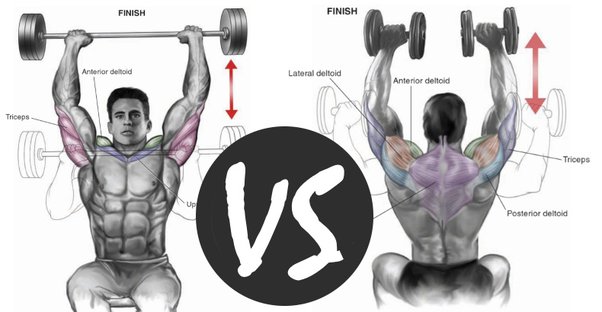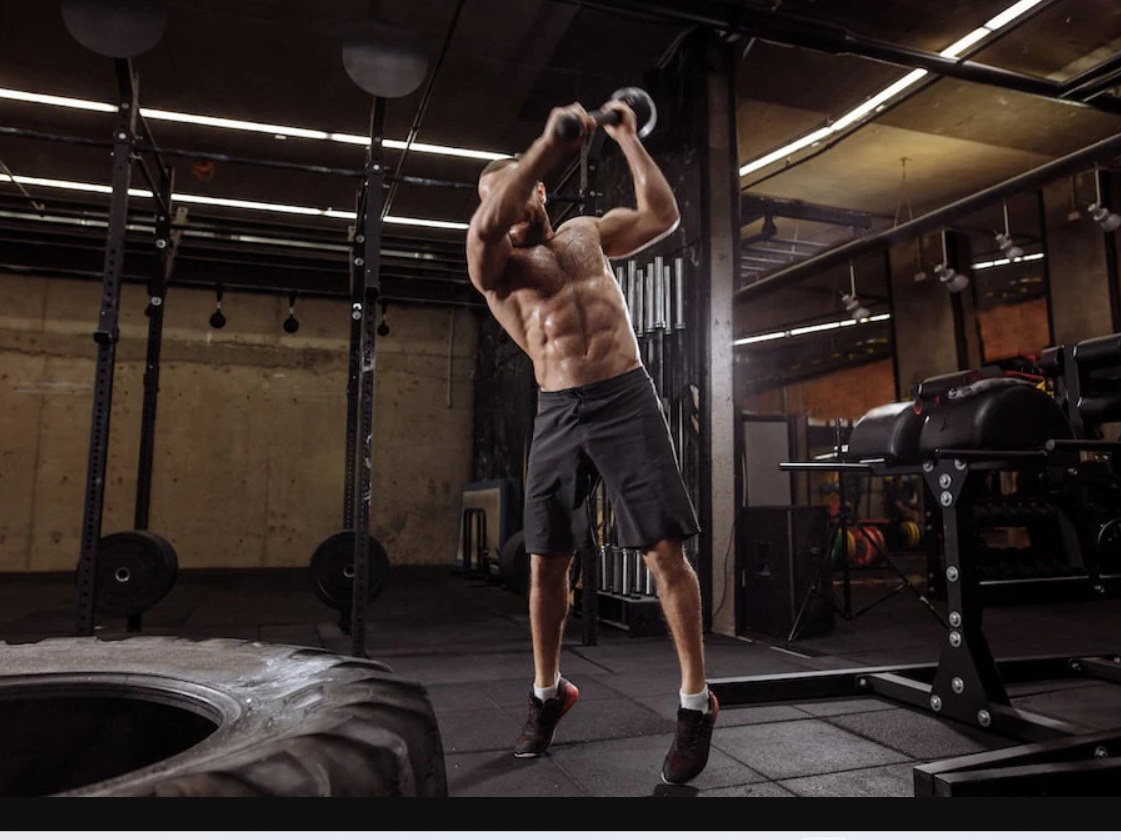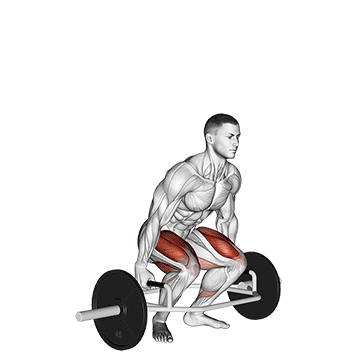While often used interchangeably, the military press typically refers to a standing overhead press with a barbell, whereas the shoulder press can encompass variations using dumbbells or machines. The choice between these exercises often depends on individual preference, equipment availability, and specific training goals. Both exercises effectively target the shoulders and can be incorporated into a well-rounded strength training program.
The distinction between the military press and shoulder press lies in their execution and equipment variations. The military press, synonymous with a standing barbell overhead press, emphasizes stability and raw strength, making it ideal for those seeking traditional shoulder development. In contrast, the shoulder press encompasses a broader spectrum, allowing for versatility with dumbbells or machines. The selection between these exercises hinges on personal choice, access to equipment, and specific fitness objectives, ensuring effective shoulder engagement within a comprehensive strength training regimen.
Understanding the Difference Between Military Press and Shoulder Press
When it comes to strength training, exercises that target the shoulders often include variations of pressing movements overhead. Two commonly used exercises for this purpose are the military press and the shoulder press. While these exercises share similarities in their basic concept, there are distinct differences in execution, muscle engagement, and equipment used. Let's delve deeper into each exercise to understand their unique characteristics and benefits.
Key Differences between the Military Press and Shoulder Press
The key differences between the military press and shoulder press lie in several important aspects. First, the equipment used sets them apart: the military press is typically performed with a barbell, emphasizing a stable grip and overhead lifting, whereas shoulder press exercises can utilise barbells, dumbbells, or machines, offering more flexibility in equipment choice.
In terms of muscle emphasis, both exercises primarily target the deltoid muscles of the shoulders. However, the military press often places a stronger emphasis on strict form and shoulder stability, requiring controlled movements to lift the heavy barbell overhead.
Additionally, the military press engages additional muscle groups more prominently compared to some variations of the shoulder press. It actively involves the triceps and upper chest muscles to provide support and stabilization during the movement.
Stabilization and core engagement are critical components of the military press. Lifting a heavy barbell overhead demands significant core stabilization to maintain proper posture and prevent overarching of the lower back. This aspect sets the military press apart from many shoulder press variations, which may require less core engagement depending on the equipment and form used.
Lastly, the shoulder press encompasses a wider range of exercises and variations, offering versatility in targeting the shoulders and accommodating different fitness levels and preferences. This versatility allows individuals to tailor their workouts based on equipment availability, training goals, and specific muscle targeting needs.
To better understand the differences between the military press and shoulder press, let's break down their key distinctions in a tabular form:
|
Aspect |
Military Press |
Shoulder Press |
|
Equipment used |
Typically performed with a barbell |
Can be performed with barbells, dumbbells, or machines |
|
Grip |
Hands slightly wider than shoulder-width |
Grip width can vary based on preference and equipment |
|
Muscle Emphasis |
Emphasises deltoids (shoulders) |
Primarily targets deltoids (shoulders) |
|
Additional Muscles |
Engages triceps, upper chest, and core |
Engages triceps and core muscles |
|
Stabilization |
Requires more core stabilization |
May require less core stabilization depending on the variation |
|
Standing Variation |
Often performed standing |
Can be performed standing, seated, or with incline/decline |
|
Range of Motion |
Generally uses a fixed range of motion |
Range of motion can vary based on equipment and form |
|
Complexity |
More emphasis on strict form and stability |
Can accommodate variations in grip and movement |
|
Variations Available |
Seated military press, dumbbell variations |
Dumbbell shoulder press, machine shoulder press |
Both exercises are effective for building shoulder strength and can be incorporated into strength training routines based on individual preferences, equipment availability, and desired muscle emphasis. The choice between military press and shoulder press often depends on specific training objectives and the desired level of challenge and variation in the workout routine.
Military Press
The military press, also known as the overhead press or barbell press, is a classic exercise that specifically targets the deltoid muscles of the shoulders. Here's a breakdown of the key features of the military press:
The military press involves pressing a barbell overhead while standing or seated. It emphasizes lifting the weight directly above the head with a focus on shoulder strength and stability.
Equipment used
Typically performed with a barbell, the military press requires a grip slightly wider than shoulder-width apart.
Muscle Worked
During the military press, the primary focus is on targeting the deltoid muscles, which consist of three distinct heads: the front (anterior), side (lateral), and rear (posterior) deltoids. These muscles work together to lift and stabilize the weight overhead during the exercise.
Deltoid Muscles
Front Deltoid (Anterior), The front deltoid is located at the front of the shoulder and plays a significant role in lifting the weight initially from shoulder height to overhead. It is primarily responsible for shoulder flexion.
Side Deltoid (Lateral), Positioned on the lateral aspect of the shoulder, the side deltoid assists in lifting the weight to shoulder height and contributes to the lateral movement of the arms during the press.
Rear Deltoid (Posterior), Situated at the back of the shoulder, the rear deltoid aids in shoulder extension and provides crucial stability during the lowering phase of the military press.
The triceps muscles, located on the back of the upper arm, act as synergists during the military press. They assist in extending the arms overhead, complementing the primary movement performed by the deltoids.
Upper Chest Muscles
The upper chest muscles (pectoralis major) also play a supportive role during the military press by stabilising the shoulders and contributing to the pressing movement. They help maintain proper posture and balance throughout the exercise.
By engaging these muscle groups synergistically, the military press not only targets the shoulders comprehensively but also involves the triceps and upper chest muscles in a coordinated effort to lift and stabilise the weight overhead. This holistic approach to muscle engagement contributes to overall upper-body strength, stability, and functional fitness.
Variations
Variations of the military press include seated military press (provides back support and reduces lower back strain) and single-arm dumbbell military press (challenges stability and symmetry).
How to do Military Press?

- Stand with feet shoulder-width apart and grip the barbell with your fingertips, elbows pointing forward.
- Rest the barbell on the front of your shoulders, across your collarbones.
- Drop into a shallow squat, centering your weight under the barbell. Press up through your heels, driving the bar directly above your head until your arms are straight.
- Lower the barbell down to your chest in a controlled manner, maintaining a neutral spine throughout the movement.
Shoulder Press
The term "shoulder press" is more encompassing and can refer to a variety of overhead pressing exercises targeting the shoulders. Shoulder press exercises involve pressing weight overhead to target the shoulders. This can include barbell presses, dumbbell presses, and machine presses.
Equipment used
Shoulder presses can be performed with various equipment, including barbells, dumbbells, or machines, allowing for different grip widths and hand positions.
Muscle Worked
Shoulder press is a compound exercise that primarily targets the deltoid muscles of the shoulders. However, it also engages several other muscles to support the movement and stabilize the body. Here are the main muscles worked during a shoulder press:
Deltoid Muscles
Front Deltoid (Anterior), The front part of the deltoid is heavily engaged during the shoulder press, especially when lifting the weight from shoulder height to overhead. It is responsible for shoulder flexion.
Side Deltoid (Lateral), The lateral deltoid assists in lifting the weight to shoulder height and contributes to the lateral movement of the arms during the press.
Rear Deltoid (Posterior), The rear deltoid plays a role in stabilizing the shoulder joint and supporting shoulder extension during the lowering phase of the press.
The triceps muscles, located on the back of the upper arm, are engaged to extend the arms overhead during the press. They provide additional force to assist the deltoids in lifting the weight.
Trapezius (Upper)
The upper trapezius muscles, located at the top of the shoulders and neck, help stabilize the shoulders during the press. They assist in keeping the shoulders steady and prevent excessive shrugging.
Upper Chest (Pectoralis Major)
The upper portion of the pectoralis major muscles, located in the chest area, is involved in stabilizing the shoulders and providing support during the shoulder press.
Core Muscles
The core muscles, including the abdominals and lower back, play a crucial role in stabilizing the body during the shoulder press. Maintaining a strong core helps prevent excessive arching of the lower back and promotes overall balance and posture.
Rotator Cuff Muscles
The rotator cuff muscles, including the supraspinatus, infraspinatus, teres minor, and subscapularis, work together to stabilize the shoulder joint during the press. They help maintain proper shoulder alignment and prevent injury.
By incorporating the shoulder press into your strength training routine, you can effectively target multiple muscle groups in the shoulders, arms, and core, promoting balanced muscle development and functional strength. Adjust the weight and intensity based on your fitness level and goals to optimise the benefits of this compound exercise.
Variations
Shoulder press variations include dumbbell shoulder press, Arnold press (rotational shoulder press), seated machine shoulder press, and incline/decline shoulder press.
How to do Shoulder Press with Dumbbells?

- Sit on a bench with back support or stand with your feet shoulder-width apart (standing variation).
- Hold a dumbbell in each hand at shoulder height, palms facing forward, with elbows slightly bent.
- Inhale and brace your core.
- Press the dumbbells overhead simultaneously by extending your arms upward.
- Keep the dumbbells close to your body and avoid arching your back excessively.
- Lock out your elbows at the top of the movement, with the dumbbells directly overhead.
- Lower the dumbbells back down to shoulder height in a controlled manner while exhaling.
- Perform the desired number of repetitions (e.g., 8-12 reps per set).
Choosing the Right Exercise
The choice between the military press and shoulder press depends on individual goals, equipment availability, and training preferences. Both exercises are effective for developing shoulder strength and can be integrated into a well-rounded strength training routine. Beginners may benefit from starting with dumbbell variations of the shoulder press to master proper form before progressing to more complex exercises like the military press.
In summary, while the military press and shoulder press share common objectives of strengthening the shoulders, they differ in terms of equipment, muscle emphasis, and variations. Understanding these differences can help you select the most suitable exercises to achieve your fitness goals and optimize your shoulder training routine.
Conclusion
In conclusion, the comparison between the military press and shoulder press reveals distinct nuances that cater to different training preferences and goals. The military press, characterized by its use of a barbell and emphasis on strict form and stability, places a strong focus on shoulder strength and overall upper-body stability. This exercise engages not only the deltoid muscles comprehensively but also recruits the triceps and upper chest muscles, along with demanding significant core stabilization.
On the other hand, the shoulder press encompasses a broader range of exercises utilizing various equipment like barbells, dumbbells, or machines. While the primary target remains the deltoid muscles, the shoulder press offers versatility in grip, range of motion, and complexity, accommodating different fitness levels and preferences.
Ultimately, the choice between the military press and shoulder press depends on individual goals, equipment availability, and desired muscle emphasis. Beginners may find starting with dumbbell variations of the shoulder press beneficial for mastering proper form before progressing to more advanced exercises like the military press.
By understanding these differences and incorporating suitable exercises into a well-rounded strength training routine, individuals can optimise shoulder development, enhance overall upper-body strength, and progress towards their fitness objectives effectively. Whether aiming for strict form and stability with the military press or exploring variations with the shoulder press, both exercises contribute to comprehensive shoulder training and overall physical fitness.










